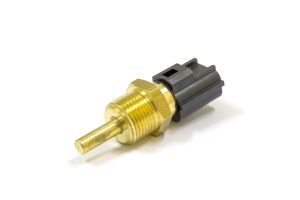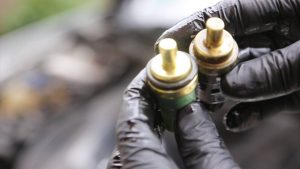Modern vehicles are equipped with an array of sensors that ensure the engine runs smoothly, efficiently, and safely. Among these, the engine coolant temperature (ECT) sensor plays a crucial role in monitoring one of the most important variables in engine operation — temperature. Without it, your car’s engine control unit (ECU) wouldn’t know if the engine is cold, warm, or overheating, leading to poor performance, excessive fuel consumption, or even severe engine damage.
In this comprehensive guide, we’ll explore how coolant temperature sensors work, why they’re vital to engine operation, signs of failure, how to test them, and when it’s time to replace them.
What Is an Engine Coolant Temperature Sensor?

An Engine Coolant Temperature (ECT) sensor is a small, thermistor-based sensor that measures the temperature of the engine’s coolant. It sends this data to the ECU, which then adjusts fuel injection, ignition timing, and cooling fan operation based on the temperature reading.
In most vehicles, the ECT sensor is located near the thermostat housing or directly on the engine block where coolant flow is most consistent.
How Engine Coolant Temperature Sensors Work
The ECT sensor works on a simple principle: the resistance of its internal thermistor changes with temperature. As coolant temperature rises, the sensor’s resistance drops, allowing the ECU to interpret the data as a temperature reading.
Here’s a simplified breakdown of the process:
-
Coolant Temperature Changes: As the engine heats up, so does the coolant.
-
Thermistor Resistance Varies: The thermistor inside the sensor reacts to temperature changes — resistance decreases as temperature increases.
-
Signal Sent to ECU: The sensor sends a voltage signal proportional to the resistance.
-
ECU Adjusts Engine Parameters: The ECU uses this data to control fuel mixture, ignition timing, cooling fan activation, and more.
Temperature vs. Resistance Table (Typical NTC Sensor)
| Coolant Temperature (°C) | Sensor Resistance (Ohms) |
|---|---|
| -20 | 12,000 – 14,000 |
| 0 | 5,000 – 6,000 |
| 20 | 2,500 – 3,000 |
| 80 | 300 – 400 |
| 100 | 180 – 200 |
NTC = Negative Temperature Coefficient (resistance decreases as temperature rises)
Why the ECT Sensor Is So Important
The data provided by the ECT sensor influences many key engine functions. If the sensor fails or sends incorrect readings, the engine control system can’t make accurate adjustments, leading to poor performance or overheating.
Key Roles of the ECT Sensor:
-
Fuel Injection Control: Adjusts fuel mixture for cold starts or warm operation.
-
Ignition Timing: Ensures the spark occurs at the right time based on temperature.
-
Idle Speed Control: Modifies idle speed during engine warm-up.
-
Cooling Fan Activation: Turns on the radiator fan to prevent overheating.
-
Emission Control: Helps maintain optimal combustion for cleaner emissions.
Signs of a Failing Coolant Temperature Sensor
A malfunctioning ECT sensor can cause a variety of performance issues. Some are subtle, while others can lead to serious engine damage if ignored.
Common Symptoms:
-
Check Engine Light (CEL): The ECU detects abnormal signals from the sensor.
-
Hard Cold Starts: Incorrect temperature readings cause rich or lean fuel mixture.
-
Poor Fuel Economy: Engine runs too rich or too lean due to wrong data.
-
Overheating or Overcooling: Cooling fan may not engage or disengage properly.
-
Rough Idling or Stalling: Incorrect fuel-air mix affects combustion stability.
-
Black Smoke from Exhaust: Too much fuel injected during combustion.
How to Diagnose a Faulty Coolant Temperature Sensor
Before replacing the sensor, it’s worth confirming it’s the actual cause of the problem. Here’s a step-by-step approach:
Diagnostic Checklist:
-
Scan for Trouble Codes: Use an OBD-II scanner. Common codes: P0115–P0119 (ECT sensor circuit issues).
-
Check Sensor Readings: Compare live data from the scanner with actual engine temperature.
-
Inspect Wiring and Connector: Look for corrosion, damage, or loose connections.
-
Measure Resistance: Remove the sensor and test it with a multimeter at different temperatures.
-
Check for Coolant Leaks: Leaks near the sensor can affect its accuracy.
When and How to Replace an Engine Coolant Temperature Sensor
Like many sensors, ECT sensors degrade over time due to heat cycles, coolant contamination, and general wear. Most last between 100,000 – 150,000 km, but replacement might be needed sooner if symptoms appear.
Replacement Steps:
-
Let the Engine Cool: Never remove the sensor from a hot engine.
-
Drain Some Coolant: Reduce coolant level below the sensor location.
-
Disconnect the Battery: Prevent short circuits.
-
Unplug Sensor Connector: Carefully disconnect the wiring harness.
-
Remove the Sensor: Use a wrench or socket to unscrew it.
-
Install New Sensor: Apply thread sealant if recommended.
-
Reconnect Everything and Refill Coolant: Then bleed the system if necessary.
Recommended Maintenance Schedule
| Action | Interval | Purpose |
|---|---|---|
| Inspect wiring & connectors | Every 20,000 km | Prevents signal loss |
| Check for trouble codes | Every 10,000 km | Early detection |
| Clean sensor area | During coolant service | Ensures accurate readings |
| Replace ECT sensor | 100,000 – 150,000 km | Prevents performance issues |
Choosing the Right Coolant Temperature Sensor

When replacing your ECT sensor, always choose a high-quality part that matches OEM specifications. Poor-quality sensors may provide inaccurate readings, leading to fuel wastage or engine damage.
You can find reliable options and buy Engine Coolant Temperature Sensors online for your specific vehicle model to ensure proper performance and long-term reliability.
Conclusion
Though small and often overlooked, the engine coolant temperature sensor is one of the most important components for engine efficiency, performance, and longevity. It provides essential data that helps the ECU manage fuel injection, ignition timing, cooling, and emissions.
A failing sensor can lead to hard starts, poor fuel economy, overheating, or even severe engine damage. By recognizing the warning signs, testing the sensor when needed, and replacing it proactively, you can ensure your engine runs smoothly and efficiently for years to come.
Regular inspections and timely replacement are simple yet crucial steps in keeping your vehicle’s heart — the engine — healthy and performing at its best.